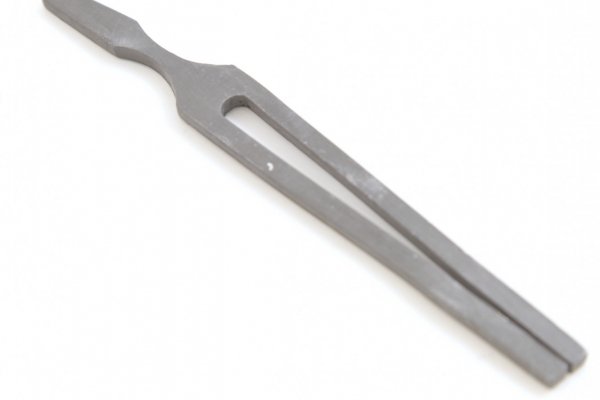
Tuning forks are so named because they are used to help tune musical instruments, but they also have a variety of other uses. They are used by audiologists to test for certain kinds of hearing loss, by the police to calibrate the radar guns used to identify speeding vehicles, and by alternative healers as an (unproven) way of improving mental clarity and physical energy. They can also apparently be used by medics to detect a bone fracture in a pinch if no x-ray is available. The applications all rely on the fact that when a tuning fork is struck, that energy is converted into vibrational energy, and its tines oscillate at a particular frequency to produce a specific pitch of note.
This lead tuning fork is one of a set of 16 made in 2009 by our Director Zoe Laughlin as part of her PhD research. Together they investigate the acoustic properties of materials and demonstrate the physics of sound and vibration. Three principle factors influence the production of sound by a tuning fork: the shape of the fork, and the density and elastic modulus (a measure of stiffness) of the material from which the fork is made. Each of the set of tuning forks is the exact same shape, but is made from a different material (an array of metals, woods, plastics and glass). Playing these tuning forks allows us to directly compare how the density and elastic modulus of each material affects the sound the fork produces.
When these tuning forks are struck, the density and elastic modulus of the material determine how much energy is absorbed and how much is converted into vibrations and audible noise. These material properties will also affect how high or low the note that is produced is (acoustic pitch) as well as how long the tuning fork rings for (acoustic brightness).
This lead tuning fork has a matte, dark grey appearance and is the most dense of the set. When struck, it makes no audible sound but produces a slow vibration that can be felt in the hand. As you can see from its wonky tines, the lead tuning fork can be easily deformed when struck, no matter how delicately it is played. The lack of audible sound is the result of lead’s density: when struck, this material absorbs most of the energy as it deforms and vibrates very little. The fork’s ability to deform is due to the material’s softness and malleability.
Sample ID: 722
Particularities
- Selections
- Sound
- Categories
- Metal
- Curiosities
- Relationships
- Lead | Sound | Sound of Materials | Tuning Fork
Add materials you find interesting to your own selections.
Use the  button to select a material and get started.
button to select a material and get started.



